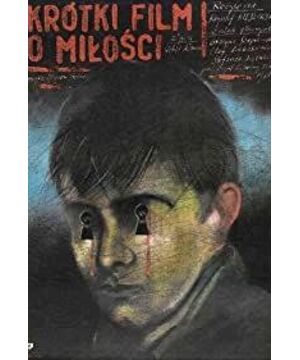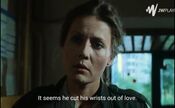The playwright Robert McGee once said: "The story master’s choice and arrangement of events is his ingenious work on the interrelationships between all levels of social reality (personal, political, environmental, and spiritual). Yu. Peel off the surface layer of his characterization and setting of scenes, the inner layer of the story expresses the author's personal view of the universe, and his deep insights into the deepest patterns and motivations of all things in the world—this is what he hides for life. The map painted by Qiu Xu.” And under the surface of the story material, it contains the more ambitious philosophy, values, human nature and life of the film author. In the film of the famous Polish director Kieslowski, the wandering and uneasy 24 frames per second carries not only the ordinary plot/story, but also the process of escaping from the real life and entering the world of sound and painting. Begin to pay attention to the puzzle of life. In the movie, we use "choice" and "resistance" to deconstruct the level of "me" more clearly, so it is easier to understand ourselves. "The Ten Commandments" filmed from 1988 to 1989 is such an extraordinary masterpiece. The ten fragmented stories in "The Ten Commandments" all use the fullest emotions to let the audience understand the moral fables of how modern people struggle under the complicated logic of existence. Every story has the deepest humanitarian sentiment from Kieslowski’s heart, and this sentiment "is not kitsch sensation or cheap optimism, or even a ray of tolerance or warmth; it only means to people ’S most basic expectations and trust" , It is just a creation of Chu, an ultimate line of defense, a pessimistic but vaguely faint starry hope. 1. In the world of the lonely, how to redeem self-loneliness? Solitude and destiny are the eternal themes of Kieslovsky's films. The pioneer of existentialism, Soren Kierkegaard, believes: “Man is a synthesis composed of infinite and finite, eternal and temporary, freedom and necessity, and soul and body. Being in constant generation. Only as survival can a person have uniqueness, and only the ability to make decisions and choices autonomously and independently. Everyone’s actual existence is the result of self-selection. Everyone’s personality is also different. What is given must be obtained by self's choice. Human existence can have three different types of life, that is, three different life realms, namely aesthetics, ethics, and religion." As an "existing" individual, one The modern director who uses films to explore the spiritual dilemma and ultimate value of "existence", Kieslovsky’s own spiritual world, and his film world are all intertwined and paradoxical processes in the three realms of aesthetics, ethics, and religion. . He experiences infinite in his finite heart, comprehends and realizes his own existence in the experience. In his film world, man cannot completely overcome his fragility, cannot resist the secular and sinful temptation; but man tries to establish at the same time. Connect with God to reach eternity and infinity. "The Ten Commandments: Love Short Film" is the most lyrical of the ten movies, but in this video space full of love words, the hero and heroine still cannot escape the eternal fate that plagues them. At the beginning of the film, the soothing and gentle movement, the lush green environment and the shy male protagonist, Tomek, the post office worker, seems to imply that the people in "The Ten Commandments: Short Film of Killing" (hereinafter referred to as "The Commandments") are "thrown away" The pain and depression caused by the infinite enlargement of the state have been relieved. The male protagonist is fascinated by the free and easy female artist Magda in the opposite building. Every night, his alarm clock will ring at 8:30, which is the time for her to go home: Tomek "woke up at this time" ", opened the binoculars to spy on her every move. Only then did Tomek feel that life is the most valuable. In addition, he put a fake money order in her mailbox so that Magda could go to the post office and talk to herself. When the voyeur was discovered by Magda and her friends, Tomek finally expressed his admiration to Magda. But Magda, who thought she had seen through the world, did not believe in such a simple love. The two of them met in Magda's apartment. Magda held Tomek's trembling hand and stretched out her bare thigh. Then she was cold again Bingbing said, "This is all about love. Now you can go to the bathroom and clean yourself." Tomek suddenly collapsed. After returning home, he chose to commit suicide by cutting his wrist in the bathroom. But he was rescued by the landlord's wife who witnessed the two men's erotic moments in the binoculars. On the other end of the telescope, Magda, who did not know, also regretted her decisive attitude. While Tomek was in hospital, Magda hoped to visit him in the hospital, but the landlord’s wife refused. Finally, Magda saw Tomek again at the post office, and Tomek only said: "I don't peep at you anymore." The TV series ended in Magda's helpless eyes. Hope to love and be loved, to be accepted, and to be understood, these stubborn resistance to loneliness and destiny suddenly vanished after the phrase "I no longer peeping at you" was said. When the communication of love cannot be reached, what you can see through the telescope can only be the loneliness and suffering of love. The warm atmosphere created in the opening chapter is gradually diluted by the strong emotional tension of "alienation". Tomek also psychologically grows from a "boy" who struggles to resist loneliness to a "man" who silently accepts the fate of loneliness. "The refusal to peep is a formal declaration of Tomek's abandonment of the French literary critic Roland Barthes' "lover's talk". He has become a subject in a social sense, a modern society full of alienation and absurdity. Therefore, such an adult appearance (although not in its classic mode: wedding) means the loss and exile of potential salvation in "Lovers' Talk"." After the film symbolically constructed Tomek's "coming-of-age ceremony" process, it successfully realized the transposition of the "lovers" image. When Magda was waiting at the window, expecting Tomek's window to shine again, she had replaced the latter and became the lonely lover in the love situation. As a result, the transition of roles and the alternate absence of the lover and the loved one makes the whole love story an endless loop structure. As long as people still live in the material world, such loneliness will never end. At the end of the film, Magda remembered the silent phone call that Tomyk had called her, but when she dialed the number and thought she could confide in Tomyk, she got an inexplicable answer from her former boyfriend. The director told her with this design. Us: At both ends of the phone, there is only a lonely person suffering from babble and a fictitious anonymous listener. The setting of distance and space is also used by Kieslowski to express the image of loneliness. Kieslowski’s movie space refers to the space of the soul, which is integrated with the living conditions of the movie characters. The window frames, the aisles between floors and the telescope used for peeping in the film all metaphor the spatial and psychological distance between Tomek and Magda. The glass of the post office counter that separates Magda and Tomek is also like a screen, separating the two indiscriminately between the two ends. Two different stories are staged. Tomek’s inner phantom and reality struggle are all here. The transparent screen is displayed, and the glass has become the product and block of this dream. When the close-up shot of Tomek was taken, Magda on the glass almost overlapped him, and the two seemed to be kissing each other, which vividly expressed Tomek's unrequited love. As an art of time and space, the claustrophobic space where Tomek lives, and the narrow field of view limited by the telescope, make the audience realize that small individuals are just trapped in these enclosed areas, and the restriction and crampness make the protagonist face loneliness , Facing fate, appear more powerless. In the world of Kieslowski's lonely man, the place has disappeared, and he has never seen it before. 2. Peeping: Sin and Salvation "Peeping/Counter-peeping" is also an important plot development motive in "The Commandment". Tomek was in deep pain because of peeping/being peeped, but he was finally saved and realized the "sublimation" of reality. ; Magda redefines what love is in peeping/being peeped. The audience is also through another sense of "peep", in the paradox of sin and salvation, to understand the question that Kieslovsky sends to the world. "Gaze" (Gaze), as a popular term in contemporary literary criticism theory, has traditionally been associated with male hegemonism and visual hegemonism. Excessive power to flog. In the field of film, Hitchcock's "Rear Window" and Antonioni's "Magnification" have creatively used the plot mode of "gaze" to clarify their unique philosophical and aesthetic views. "The development of modern film theory and the unique media reflexive characteristics of modern art have made people realize that in a sense, peeping and voyeurism are just one of the important factors that constitute the cinema mechanism, the psychology of watching movies, and the film narrative mechanism. The first is that the camera lens is acting as the'night-legged devil'-the peeper of other people's lives, inducing what Freud called the initial situation. Therefore, the story of presenting a peeper has become a modernist film that constitutes its reflexivity. One of the ways to refer to the media." The story of the peeper and the peeper has gradually become a "new" film narrative mode: the protagonist in the film and the peeper are mostly "paralyzed" in a certain sense, he ( They) lose or lack the ability and possibility to take action in reality to varying degrees. This is true of Jeffries in "Rear Window", Thomas in "Zoom", and Tomek in "The Commandment". But unlike Hitchcock's in-depth exploration and exploration of the negative theme of "peeping", Kieslowski bestowed more sympathy and social invisible oppression and restraint on the protagonist Tomek. Then, the whole "Love Commandment" is not simply a recapitulation of "Rear Window" in the plot, but has become a "moral anxiety" movie that is consistent with the social and historical background of Poland and the psychological status quo of the Polish people at that time. . Tomek peeped at Magda using a telescope and passed through the square window frame between the houses on both sides. Nothing is closer to the theater situation/movie situation than peeking through the window and the lens of the story. The window frame on the opposite window becomes the counterpart of the picture frame. It limits the scope, just like the world of light and shadow on the screen, which is obscured by the curtain; the situation in the opposite window depends on the light source: only when the light is on, everything "Existence" becomes visible. Such existence also heralded the existence of Tomek's "life" before Magda confessed. And this visible "picture" is always dull and silent. The peeper at this end is like the audience in the theater. The distance between him and the peeping object is constant. Only with the help of optical equipment can he change this distance visually, thus obtaining an imaginative participation in the life of the other party. With the help of tools From "the silent other" to "participating other". So far, Magda's life is unified with Tomek's peeping behavior. When Magda started dinner alone in the telescope, the camera turned to Tomek and bit his first bite of bread. The two sets of shots were intersected together, which is the last dream of Tomek and Magda having dinner together. More meticulously, when the gas repairman in the telescope came to Magda’s house to interrupt her tryst with her lover, Tomek’s mischievous laughter came from outside the painting. "When contact is impossible, the desire to peek has the upper hand" (Satyr) Tomek uses a high-powered telescope to experience sharing an ordinary life with Magda in an illusion space shared with Magda. The happiness of life has realized the recognition of self-life value. When this "peeps" was seen through and Magda's "counter-peeps" power made Tomek feel unsuitable, the one-way, unknown and subtle balance between the two was also lost. Broke. The alienating power of "peeping" has completely ruined the already slim communication opportunities. In the struggle for the dominance of the "peep", Tomek's soul was deeply hurt by Magda's indifference, and Magda seemed to have won the confrontation between the two, but she also completely lost acceptance. The possibility of love. As a result, she changed from being a peeper to a peeper, but the spotlight that she saw in Tomek's dark room was only a phantom that she imagined in her heart to linger with him. The confession of love can only be exchanged for painful self-harm, and loneliness is the existence that can never be resolved. The theme of voyeurism finally merges with the theme of loneliness, pointing directly to the spiritual dilemma of modern people. Another special peeper is the "mysterious bystander" that runs through the Ten Commandments. He has always appeared from the point of view of "looking at the camera", looking directly at the camera lens for a few seconds every time he appears. although He never spoke, but the audience clearly felt the questioning of himself in the indifferent but deeply helpless gaze. The eyes of the mysterious bystander shined through the screen, connecting the two time spaces inside and outside the screen, destroying the self-sufficient psychological world of the “selfish” who were watching in the dark. The audience can't help but ask themselves beyond the story of the movie: Who is he? Is he looking at me? As if the mind was stripped from the body by this scrutiny gaze, the humbleness and tingling in life had nowhere to escape. Behind the endless loneliness, Kieslowski used his Sophocles-style compassion to present an elegy to the tragic fate of mankind. He believes in the power of salvation. He believes that although others are hell and waiting is the prolongation of pain, in this pain, one can still feel the existence of life essence. Magdana’s sobbing back in "The Commandment" shows the truth of her isolation and helplessness, and it is that when she finally confronted Tomek out of sympathy, the latter became the only one who could share her own with her. The object of memory and pain: she can only talk to him, and she can only talk to him about the man who appeared in her life in the autumn, and she can only talk to Tomek about her miserable and melancholy: "He is leaving I have never come back again..." It was loneliness that made Magda choose a lifestyle that violates the "no adultery" commandment. As a change in styling factor, Magda tied her long hair for the first and only time, which symbolizes self-restraint and the choice to face the bleak life of being alone. At the same time Magda closed her curtains for the first time. She gave up peeping and locked the window where she was peeping. She began to close the window of her heart for a specific person, a specific love. Magda waited for Tomek, because she had to tell him in person: "You are right." Love exists. Because she is already in love. The movie version of "The Commandments" has a sad and warm ending. It is the establishment of contact and communication, that is the arrival of salvation, and that is the ending of a classic love story. Magda seemed to see herself crying at the desk and the moment when her loneliness was exposed. At this moment Tomek walked in, and he stroked her shoulder tenderly and brotherly. Magda looked up at him, resting her head in his arms with boundless trust and comfort. At this time, Magda in reality opened her eyes wide, and tears of happiness and expectation filled her eyes. A warm warm color hung over her cheeks. As Dai Jinhua said, that is only the desire and yearning for salvation, not the arrival of salvation. However, a reality with dreams and expectations, after all, is stronger than a dreamless sinking and death-like life. For Kieslowski, peeping can be sympathetic, not just representative; it can be protective, not just a symbol of pornography. Just like, only the landlord's wife saw Tomek's embarrassed escape from prying eyes, and it made it possible to save Tomek. "The peeper becomes the victim" and the "the peeper becomes the redeemer". Under the semantic field of "peeping", we may find more. 3. The perpetual Kieslovsky's "The Commandments" and "The Commandments", both in the movie version and in the TV series, have set off a wave of movie watching in Poland and the world. The TV series version of "Ten Commandments" successfully achieved the conquest of TV audiences who traditionally regarded as popcorn culture appreciators, and created more than 52% of the ratings in Poland. The in-depth discussion of human nature in the content, the unique innovations in film techniques, and the distinctive colors (such as the use of white, red, blue and other colors in the film) obviously affected the later "Red", The creation of "White" and "Blue") and the use of sound effects, which mean a variety of clear concrete figures, let us appreciate the style of a generation of art film masters. Regardless of how innovative the form is and how the times change, Tarkovsky said that "a movie is like any art, its content and objects can only be people, first of all, people, not the need to hold a certain subject matter" forever. It is the most important theme that film artists want to express. When talking about "Red", Kijeslovsky said: "There is no belief other than the belief in people." From the early discussion of the influence of politics on people to the obsessive pursuit of the ultimate value of people in the middle and later stages, perhaps Kijeslovsky, like Tomek and Magda in "The Commandment", did not seek what he thought was the most A suitable choice, but there is no doubt that Keith’s rich audiovisual vocabulary and poetic pure and detached image style are enough to influence generations of filmmakers who wish to express their true life and self. The master has passed away, and the spirit will live forever. . The in-depth discussion of human nature in the content, the unique innovations in film techniques, and the distinctive colors (such as the use of white, red, blue and other colors in the film) obviously affected the later "Red", The creation of "White" and "Blue") and the use of sound effects, which mean a variety of clear concrete figures, let us appreciate the style of a generation of art film masters. Regardless of how innovative the form is and how the times change, Tarkovsky said that "a movie is like any art, its content and objects can only be people, first of all, people, not the need to hold a certain subject matter" forever. It is the most important theme that film artists want to express. When talking about "Red", Kijeslovsky said: "There is no belief other than the belief in people." From the early discussion of the influence of politics on people to the obsessive pursuit of the ultimate value of people in the middle and later stages, perhaps Kijeslovsky, like Tomek and Magda in "The Commandment", did not seek what he thought was the most A suitable choice, but there is no doubt that Keith’s rich audiovisual vocabulary and poetic pure and detached image style are enough to influence generations of filmmakers who wish to express their true life and self. The master has passed away, and the spirit will live forever. . The in-depth discussion of human nature in the content, the unique innovations in film techniques, and the distinctive colors (such as the use of white, red, blue and other colors in the film) obviously affected the later "Red", The creation of "White" and "Blue") and the use of sound effects, which mean a variety of clear concrete figures, let us appreciate the style of a generation of art film masters. Regardless of how innovative the form is and how the times change, Tarkovsky said that "a movie is like any art, its content and objects can only be people, first of all, people, not the need to hold a certain subject matter" forever. It is the most important theme that film artists want to express. When talking about "Red", Kijeslovsky said: "There is no belief other than the belief in people." From the early discussion of the influence of politics on people to the obsessive pursuit of the ultimate value of people in the middle and later stages, perhaps Kijeslovsky, like Tomek and Magda in "The Commandment", did not seek what he thought was the most A suitable choice, but there is no doubt that Keith’s rich audiovisual vocabulary and poetic pure and detached image style are enough to influence generations of filmmakers who wish to express their true life and self. The master has passed away, and the spirit will live forever.
View more about A Short Film About Love reviews








